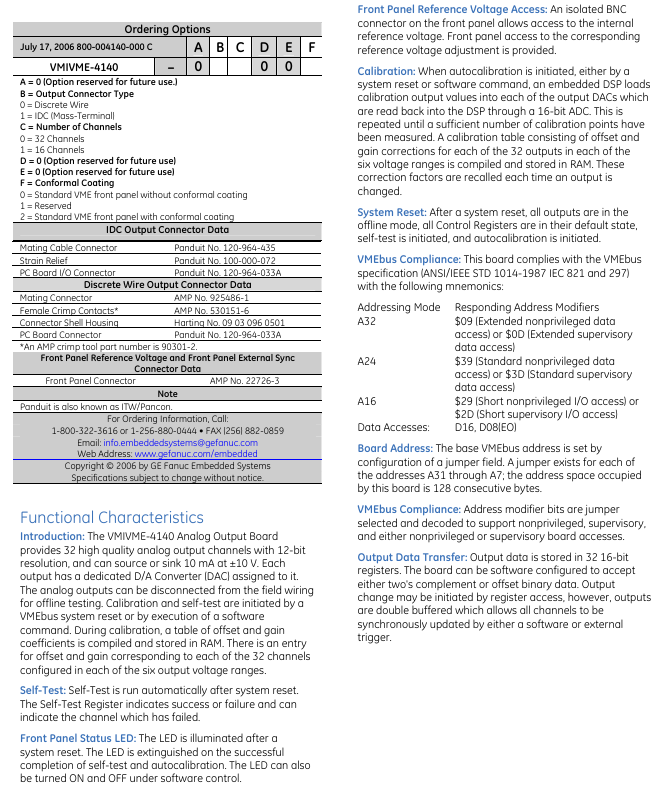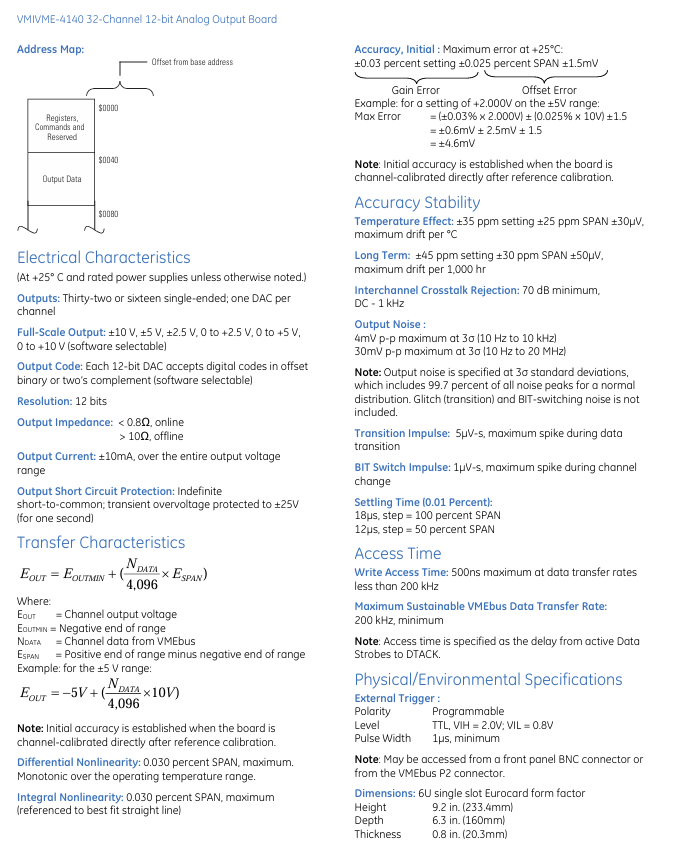

K-WANG


GE Fanuc Automation VMIVME-4140 32-Channel 12-bit Analog Output Board
GE Fanuc Automation VMIVME-4140 32-Channel 12-bit Analog Output Board
Core functions and features
Channel and Accuracy Configuration: Equipped with 32 analog output channels (adjustable to 16 channels through ordering options), each channel is equipped with an independent 12 bit D/A converter (DAC) to ensure output accuracy; Support software selection of unipolar (0 to+2.5V, 0 to+5V, 0 to+10V) or bipolar (± 2.5V, ± 5V, ± 10V) voltage range to meet different application requirements.
Output performance: The maximum output current of a single channel is ± 10mA, with an output impedance of<0.8 Ω in online mode and>10 Ω in offline mode; Equipped with output short-circuit protection function, it can withstand infinite short circuits to ground and withstand ± 25V transient overvoltage (lasting for 1 second), ensuring equipment safety.
Update and Calibration Mechanism: Supports random update (non scanning) mode, with dual buffering design for output, which can be triggered by software or external synchronization signals for updates; No manual calibration is required, only a reference potentiometer, system reset or software instructions are needed to initiate automatic calibration. After calibration, an offset and gain coefficient table containing 32 channels in 6 voltage ranges will be generated and stored in RAM for output adjustment.
Self check and diagnosis: After the system is reset, the self check program will automatically run, and the self check register can provide feedback on the results (success/failure) and fault channel information; The output can be disconnected from the on-site wiring to achieve offline self-test, while the onboard rich diagnostic testing functions are convenient for troubleshooting.
Front panel design: equipped with status LED indicator lights (lit after reset, turned off after successful self check and automatic calibration, can be controlled by software switch); Provide analog output connectors, reference voltage access interfaces (with isolated BNC connectors and adjustment functions), and external synchronous signal connectors for convenient operation and monitoring.

Technical parameters
(1) Functional characteristic parameters
Specific content of parameter category
Conversion and precision differential nonlinearity up to 0.030% range (monotonic over the entire operating temperature range); The maximum range of integral nonlinearity is 0.030% (refer to the best fitting line); Initial accuracy (+25 ℃): gain error ± 0.03% set value ± 0.025% range ± 1.5mV, offset error is calculated using the same logic as the gain error
Stability temperature drift: ± 35ppm set value ± 25ppm range ± 30 μ V/℃ (maximum); Long term drift: ± 45ppm set value ± 30ppm range ± 50 μ V/1000 hours (maximum)
Noise and interference output noise (3 σ standard deviation): maximum 4mV peak to peak value in the 10Hz-10kHz frequency band, maximum 30mV peak to peak value in the 10Hz-20MHz frequency band (excluding jump and channel switching noise); Channel crosstalk suppression: minimum 70dB in DC-1kHz frequency band
Response speed establishment time (0.01% accuracy): 18 μ s for full-scale step and 12 μ s for half scale step; Data jump pulse: maximum 5 μ V · s; channel switching pulse: maximum 1 μ V · s
Bus and access are compatible with the VMEbus specification (ANSI/IEEE STD 1014-1987 IEC 821 and 297), supporting A32/A24/A16 address modes and D16, D08 (EO) data access; The maximum write access time is 500ns (data transmission rate<200kHz), and the minimum sustainable VMEbus data transmission rate is 200kHz; The base address is set through jumper wires, occupying 128 bytes of contiguous address space
(2) Physical and environmental parameters
Specific content of parameter category
Size 6U single slot Eurocard version: Height 233.4mm (9.2 inches), Depth 160mm (6.3 inches), Thickness 20.3mm (0.8 inches)
Maximum weight 0.7kg
Temperature range: working temperature 0-+65 ℃, storage temperature -25-+85 ℃
Humidity 20% -80% relative humidity (without condensation)
Cooling method relies on forced air cooling of VMEbus chassis
Power demand+5VDC power supply, maximum current 4.0A (output at full load)
Maximum altitude of 3000m (working environment)
Mean Time Between Failures (MTBF) 107400 hours (according to 217F standard)
External trigger polarity programmable; The voltage level is TTL standard (VIH=2.0V, VIL=0.8V); Minimum pulse width of 1 μ s, can be connected through the front panel BNC connector or VMEbus P2 connector
Ordering Options and Accessories
(1) Order Code Rules
The order model format is "VMIVME-4140- A B C D E F", with each letter representing a different configuration. The specific meanings are as follows:
A: Reserved options (currently fixed at 0 for future expansion)
B: Output connector type (0=discrete wiring type, 1=IDC lumped terminal type)
C: Number of channels (0=32 channels, 1=16 channels)
D. E: Reserved options (currently fixed at 0)
F: Normal coating (0=standard VME front panel without coating, 1=reserved, 2=standard VME front panel with coating)
(2) Matching connectors and tools
Connector type, model/specification
IDC output connector matching cable connector: Panduit 120-964-435; Strain relief: Panduit 100-000-072; PCB I/O connector: Panduit 120-964-033A
Discrete wiring output connector matching connectors: AMP 925486-1 (female crimping terminal), AMP 530151-6 (connector housing), Harting 09 03 096 0501 (PCB connector); Crimping tool: AMP 90301-2
Front panel reference voltage and external synchronous connector AMP 22726-3 (note: Panduit also known as ITW/Pancon)
Application scenarios
This analog output board is suitable for industrial scenarios that require high accuracy and stability of analog signals, mainly including:
Data acquisition system: provides accurate analog output signals for the system, assisting in data acquisition and analysis.
Control system: As a control signal output unit, it drives the actuator to achieve precise control.
Precision simulation excitation: providing stable simulation excitation signals for testing and measuring equipment.
Automatic Test Equipment (ATE): In the automated testing process, specific analog signals are output to verify the performance of the tested equipment.

- YOKOGAWA
- Energy Access
- Renewable Integration
- Energy Subsidies
- Energy and Water
- Net zero emission
- Energy Security
- Critical Minerals
- A-B
- petroleum
- Mine scale
- Energy and Gender
- Covid-19
- man-machine
- Reliance
- ADVANCED
- SEW
- ProSoft
- WATLOW
- Kongsberg
- FANUC
- VSD
- DCS
- PLC
- Sewage treatment
- cement
- Yaskawa
- Woodward
- BOSCH Rexroth
- MOOG
- General Electric
- American NI
- Rolls-Royce
- CTI
- Honeywell
- EMERSON
- Automobile market
- xYCOM
- Motorola
- architecture
- Industrial information
- New energy
- electricity
- Construction site
- HIMA
- ABB
- Rockwell
- Schneider Modicon
- Siemens
- MAN
- GE
- TRICONEX
- Control Wave
- ALSTOM
- AMAT
- STUDER
- KONGSBERG
- MOTOROLA
- DANAHER MOTION
- Bentley
- Galil
- EATON
- MOLEX
- Triconex
- DEIF
- B&W
- ZYGO
- Aerotech
- DANFOSS
- KOLLMORGEN
- Beijer
- Endress+Hauser
- schneider
- Foxboro
- KB
- REXROTH
- YAMAHA
- Johnson
- Westinghouse
- WAGO
- TOSHIBA
- TEKTRONIX
-
GE Hydran M2-X Enhanced Monitoring
-
ABB REG316 1mrk000809-GA Numerical Generator Protection
-
ABB RED670 1MRK004810 Line differential protection
-
GE SR750-P5-G5-S5-HI-A20-R-E Feeder protection system
-
ABB PFTL301E-1.0KN 3BSE019050R1000 PillowBlock Load cells
-
Kollmorgen S33GNNA-RNNM-00 - Brushless Servo Motor
-
Kollmorgen 6sm56-s3000-g-s3-1325 - Servo Motor
-
Kollmorgen AKM52K-CCCN2-00 - Servo Motor
-
Kollmorgen PSR3-230/75-21-202 - Power Supply
-
Kollmorgen akm24d-anc2r-00 - Servo Motor
-
Kollmorgen AKM22E-ANCNR-00 - Servo Motor
-
Kollmorgen S60300-550 - Servo Drive
-
Kollmorgen B-204-B-21 - Servomotor
-
Kollmorgen AKM21E-BNBN1-00 - Servo Motor
-
Kollmorgen TT2953-1010-B - DC Servo Motor
-
Kollmorgen pa8500 - Servo Power Supply
-
Kollmorgen BDS4A-210J-0001-207C2 - Servo Drive
-
Kollmorgen TTRB1-4234-3064-AA - DC Servo Motor
-
Kollmorgen MH-827-A-43 - Servo Motor
-
Kollmorgen AKM24D-ACBNR-OO - Servo Motor
-
Kollmorgen 00-01207-002 - Servo Disk DC Motor
-
Kollmorgen AKM21C-ANBNAB-00 - Servo Motor
-
Kollmorgen PSR3-208/50-01-003 - Power Supply
-
Kollmorgen 6SM56-S3000 - Servo Motor
-
Kollmorgen DBL3H00130-B3M-000-S40 - Servo Motor
-
Kollmorgen 6SN37L-4000 - Servo Motor
-
Kollmorgen AKM65K-ACCNR-00 - Servo motor
-
Kollmorgen 6SM56-L3000-G - Servo Motor
-
Kollmorgen AKMH43H-CCCNRE5K - Servo Motor
-
Kollmorgen PSR4/52858300 - Power Supply
-
Kollmorgen KBM-79H03-E03 - Direct Drive Rotary Motor
-
Kollmorgen AKM33E-ANCNDA00 - Servo Motor
-
Kollmorgen U9M4/9FA4T/M23 - ServoDisc DC Motor
-
Kollmorgen AKM13C-ANCNR-00 - Servo Motor
-
Kollmorgen AKM43L-ACD2CA00 - Servo Motor
-
Kollmorgen AKM54K-CCCN2-00 - Servo Motor
-
Kollmorgen M-605-B-B1-B3 - Servo Motor
-
Kollmorgen AKD-P00606-NBAN-0000 - Rotary Drive
-
Kollmorgen 6SM-37M-6.000 - Servo Motor
-
Kollmorgen A.F.031.5 - Sercos Interface Board
-
Kollmorgen 918974 5054 - Servo PWM
-
Kollmorgen U12M4 - ServoDisc DC Motor
-
Kollmorgen AKD-B00606-NBAN-0000 - Servo Drive
-
Kollmorgen MV65WKS-CE310/22PB - Servo Drive
-
Kollmorgen 65WKS-CE310/22PB - Servo Drive
-
Kollmorgen EM10-27 - Module
-
Kollmorgen S64001 - Servo Drive
-
Kollmorgen CR03200-000000 - Servo Drive
-
Kollmorgen 6SM57M-3000+G - Servo Motor
-
Kollmorgen BDS4 - Servo Drive
-
Kollmorgen AKD-P00306-NBEC-000 - Servo Drive
-
Kollmorgen AKD-B01206-NBAN-0000 - Servo Drive
-
Kollmorgen STP-57D301 - Stepper Motor
-
Kollmorgen 6SM37L-4.000 - Servo Motor
-
Kollmorgen 44-10193-001 - Circuit Board
-
Kollmorgen PRDR9SP24SHA-12 - Board
-
Kollmorgen PRD-AMPE25EA-00 - Servo Drive
-
Kollmorgen DBL3N00130-0R2-000-S40 - Servo Motor
-
Kollmorgen S406BA-SE - Servo Drive
-
Kollmorgen AKD-P00607-NBEI-0000 - Servo Drive
-
Kollmorgen AKD-P01207-NBEC-0000 - Servo Drive
-
Kollmorgen CR03550 - Servo Drive
-
Kollmorgen VSA24-0012/1804J-20-042E - Servo Drive
-
Kollmorgen N2-AKM23D-B2C-10L-5B-4-MF1-FT1E-C0 - Actuator
-
Kollmorgen 04S-M60/12-PB - Servo Drive
-
Kollmorgen H33NLHP-LNW-NS50 - Stepper Motor
-
Kollmorgen A-78771 - Interlock Board
-
Kollmorgen AKM43E-SSSSS-06 - Servo Motor
-
Kollmorgen AKD-P00607-NBEC-0000 - Servo Drive
-
Kollmorgen E21NCHT-LNN-NS-00 - Stepper Motor
-
Kollmorgen cr10704 - Servo Drive
-
Kollmorgen d101a-93-1215-001 - Motor
-
Kollmorgen BDS4A-203J-0001-EB202B21P - Servo Drive
-
Kollmorgen MCSS23-6432-002 - Connector
-
Kollmorgen AKD-P01207-NACC-D065 - Servo Drive
-
Kollmorgen CK-S200-IP-AC-TB - I/O Adapter and Connector
-
Kollmorgen CR10260 - Servo Drive
-
Kollmorgen EC3-AKM42G-C2R-70-04A-200-MP2-FC2-C0 - Actuator
-
Kollmorgen BDS5A-206-01010-205B2-030 - Servo Drive
-
Kollmorgen s2350-vts - Servo Drive
-
Kollmorgen AKM24D-ANC2DB-00 - Servo Motor
-
Kollmorgen E31NCHT-LNN-NS-01 - Stepper Motor
-
Kollmorgen PRD-0051AMPF-Y0 - Servo Board
-
Kollmorgen TB03500 - Module
-
Kollmorgen 60WKS-M240/06-PB - Servo Drive
-
Kollmorgen M21NRXC-LNN-NS-00 - Stepper Motor
-
Kollmorgen H-344H-0212 - Servo Motor
-
Kollmorgen MCSS08-3232-001 - Connector
-
Kollmorgen AKM33H-ANCNC-00 - Servo Motor
-
Kollmorgen PA-2800 - Power Supply
-
Kollmorgen MTC308C1-R1C1 - Servo Motor
-
Kollmorgen PRDR0091300Z-00 - Capacitor Board
-
Kollmorgen BDS4A-206J-0024/01502D79 - Servo Drive
-
Kollmorgen S20330-VTS - Servo Drive
-
Kollmorgen S20250-CNS - Servo Drive
-
Kollmorgen SBD2-20-1105-WO - Servo Drive Board
-
Kollmorgen M405-C-A1--E1 - Servo Motor
-
Kollmorgen PRD-PB805EDD-00 - Servo Drive
-
Kollmorgen 6SM57S-3.000-J-09-HA-IN - Servo Motor
-
Kollmorgen AKM33H-ANCNDA-00 - Servo Motor
-
Kollmorgen PCB-00030200-04 - PCB
-
Kollmorgen H22SSLB-LNN-NS-02 - Stepper Motor
-
Kollmorgen BJRL-20012-110001 - Module
-
Kollmorgen BDS4A-206J-0001404A - Servo Drive
-
Kollmorgen H-342-H-0802 - Servo Motor
-
Kollmorgen CR10561 - Servo Drive
-
Kollmorgen BDS5A-206-00010-205B2-030 - Servo Drive
-
Kollmorgen BDS5A-206-00010-207B-2-030 - Servo Drive
-
Kollmorgen mcss08-3224-001 - Connector
-
Kollmorgen M-207-B-23-B3 - Servo Motor
-
Kollmorgen PRD-0041200Z-S0 - Encoder/Resolver Card
-
Kollmorgen MH-225-G-61 - Motor
-
Kollmorgen MT308B1-T1C1 - Servo Motor
-
Kollmorgen BDS4A-240J-0001604C83 - Servo Drive
-
Kollmorgen 6SM57-S-3000 - Servo Motor
-
Kollmorgen N-T31V-15-5B-6-MF3-FT1E-C251 - Actuator
-
Kollmorgen PRD-0051AMPA-X0 - Servo Board
-
Kollmorgen CF-SS-RHGE-09 - Cable
-
Kollmorgen DIGIFAS7204 - Servo Drive
-
Kollmorgen S30101-NA - Servo Drive
-
Kollmorgen DIGIFAS7201 - Servo Drive
-
Kollmorgen PRD-0051AMPA-Y0 - Servo Board
-
Kollmorgen AKM23D-EFCNC-00 - Servo Motor
-
Kollmorgen SE10000 - Servo Drive
-
Kollmorgen PSR4/5A-112-0400 - Power Supply
-
Kollmorgen AKM31H-ANCNC-01 - Servo Motor
-
Kollmorgen M-203-B-93-027 - Servo Motor
-
Kollmorgen CP-SS-G1HE-05 - Connector




